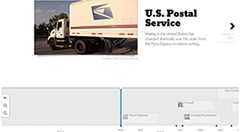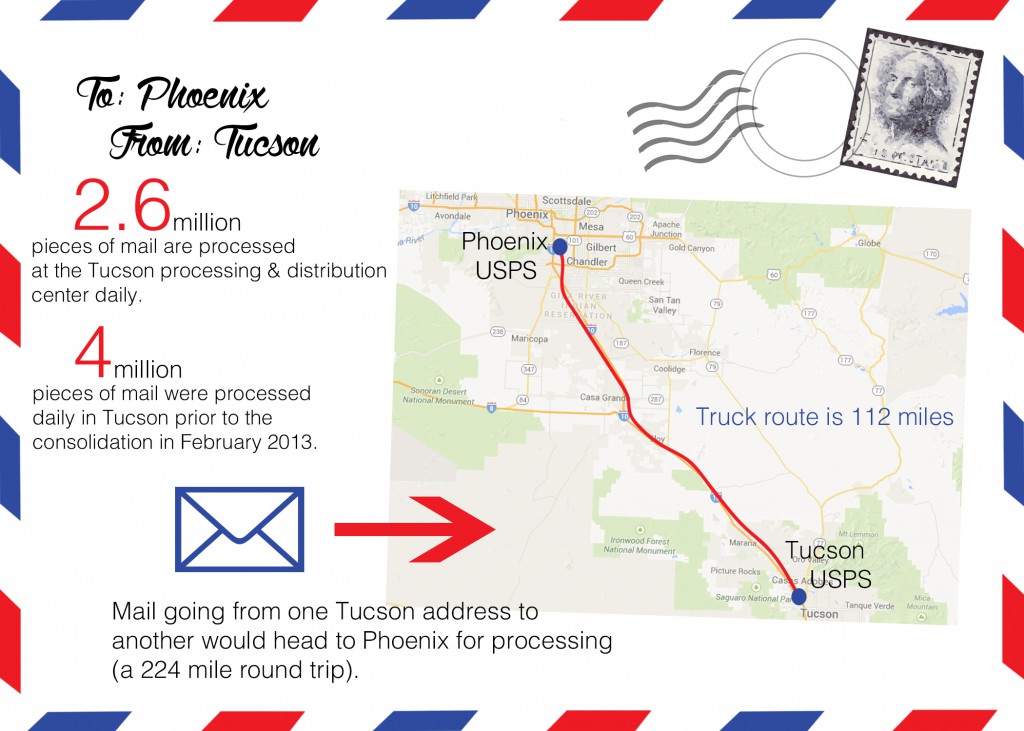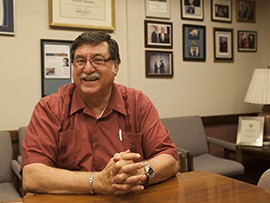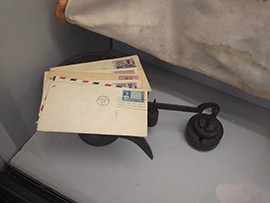Cronkite News has moved to a new home at cronkitenews.azpbs.org. Use this site to search archives from 2011 to May 2015. You can search the new site for current stories.
Mail closure in Tucson could save postal service, but cost region millions
A half dozen customers patiently wait in line at the Cherrybell post office in Tucson. It’s quiet on this weekday morning.
But just through the double doors to the right and behind the security checkpoint, workers are processing millions of pieces of mail.
It’s a scene that may soon come to a close.
While 2.6 million pieces of mail come through the Tucson processing and distribution center daily, volume has dropped nearly 5 percent from 2014. The decrease is one reason U.S. Postal Service officials put Tucson on their nationwide consolidation list.
The agency had planned to close down the processing center on Jan. 5. But officials delayed the move until July 11.
Elected leaders ¬¬– from U.S. representatives to city councilmembers – have fought the closure since September 2011, when the service announced it would consolidate more than 82 post offices across the country.
Although Cherrybell would still offer postal services – like accepting packages and delivering mail – it would stop processing mail, much of it originating in southern Arizona. The pieces would have to travel 112 miles to Phoenix, or farther, for processing. One study indicated the economic loss for Tucson would reach tens of millions of dollars.
But the postal service said the consolidation will save billions nationwide.
Tucson officials and business leaders said they feel confident their efforts could prolong or stop the downsizing.
Over the past three years, the postal service has begun shifting the processing of its mail from Tucson to Phoenix. Residents are starting to realize the impact it’s having on the city and speaking out, community members said.
Arizona is one of the nation’s Top 10 fastest growing states, and business owners said they worry that losing a mailing facility will have negative impacts.
Councilman Richard Fimbres said businesses looking to move to Tucson will look to see if it has a central mailing center to deliver products and services. If it doesn’t, he said he worries new businesses won’t invest in the city.
History of the USPS
Since 1982, the postal service has not received tax dollars for its operations. All operating revenue comes from the sale of postage and services, spokesman Peter Hass said.
Hass said with new technology like online bill payments, the American public is removing itself from the “snail mail” process and changing mailing habits.
“We have to change our business footprint to change with the times and what our customers are now doing,” Hass said.
In the last decade, the total volume of mailed packages in the U.S. has declined by more than 56 billion pieces.
The decline led the postal service to consolidate. In 2013, the first phase of these consolidations saved the postal service $1.2 billion annually, Hass said.
But the moves have had consequences.
Before the first phase, which went into effect Jan. 5, first-class mail averaged 1.8 days for delivery across the nation. After the change, the service averaged 2.1 days, Hass said.
If the service shuts down the Tucson processing center, Phoenix will have the only mailing and processing facility in the state.
Why Tucson?
Officials said the postal service did not do a thorough job in conducting its feasibility study on how the consolidation would impact Tucson.
However, the postal service looked at cost impacts, mail processing costs, transportation costs and if proposed services changes would be justified.
The postal service Audit Manager for the Office of Inspector General Matthew Hartshorn was a part of the group that performed the audit on the postal service to ensure that it studied the impact of the consolidation adequately.
The postal service will review the consolidations after six months and again after a year. These reviews evaluate whether the consolidations are beneficial, Hartshorn said.
It’s unknown if the service will make adjustments to the Tucson consolidation, the group said.
“Typically, they don’t reverse these things,” Hartshorn said.
Hass said that the Tucson consolidation makes sense because the Phoenix facility has the workforce, space and functionality to manage the additional volume of mail from the southern mailing facility.
Impact to Cherrybell
The consolidation of the Pima County mailing facility is a major loss to the local economy, according to a study done by the Fiscal Policy Institute based in New York.
The move would have a local economic loss of more than $48 million, according to the study.
The consolidation in Tucson will affect 320 employees. That includes postal clerks, mail handlers, maintenance jobs, supervisors, managers and mail truckers, according to the study.
The study also noted that the Tucson area will lose another 207 jobs in other industries that support postal operations.
The postal service won’t lay off employees because of the consolidation.
“I have to take some issue with the term ‘job loss’ because throughout the process, we still offer every single person a position,” Hass said.
The service may move employees to another position within a 50-mile radius or across the country depending on their contract, USPS officials said.
What it means for Tucson
The consolidation would not just affect those at the post office.
For those sending mail to a Tucson resident from a Tucson resident, the trip takes the mail from Tucson to Phoenix, or another processing facility outside of the state, back to Tucson.
One Tucson businessman sent a piece of mail in mid January to another Tucson resident, and the postmark shows the mail arrived in Austin, Texas, Jan. 20, where it was processed and sent back to Tucson. The recipient received the letter on Jan. 24.
Richard Lemons, commander of the Disabled American Veterans Department of Arizona, said he noticed the change when his chapter put on a fundraising event April 1.
They sent invitations to about 2,800 people in the Tucson area a week prior.
Only 50 people attended, and Lemons said that he later received calls from people apologizing for not attending because they received the invite on the day of the event or after it had occurred.
“We lost a lot of potential donations because of that,” Lemons said.
The business community is also worried about losing money.
Rick Hecox, owner of printing and mailing service Arizona Jet Mail, is concerned the Tucson closure will cost him. Currently, every piece of mail delivered in southern Arizona has a 4.4 percent discount. When the plant closes, that discount will go away, he said.
This is going to be detrimental to nonprofits, a large portion of Jet Mail’s customers, who need those discounts to function, Hecox said.
Fimbres said that he is working with Congresswoman Martha McSally and other officials on this topic. They’ve held community roundtables and on March 18, McSally lead a bipartisan letter to Postmaster General Megan Brennan opposing the closure of the Cherrybell processing and distribution center.
Tucson leaders have worked to delay the closures so far. The postal service had originally planned to fully consolidate the office in December 2011. Fimbres said he’s working to release a citywide survey this week to increase attention and conversation on the closure.
Phoenix plant will hire more workers
Phoenix is looking at a positive economic impact once the service change is completed, according the Fiscal Policy Institute.
To accommodate processing of additional mail, Phoenix plans to hire 160 clerks, mail handlers, maintenance workers and three managers.
Additionally, contracts for mail trucking will expand by $466,000 per year.
As Tucson transfers operations to the Phoenix metropolitan area, Phoenix would have a local economic gain of about $27.5 million a year in sales, according to the institute.
While Phoenix gains, Arizona’s economy would have a $21.4 million net loss, according to the study.
Hass said that the postal service will continue to adjust services to meet customer demands, but he could not speculate on what changes may come.













